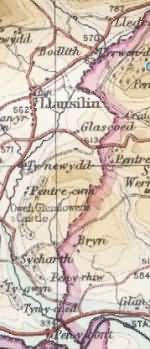Boundaries Challenged - Borders Changed
When the Anglican church in Wales was disestablished in 1920 the boundary of the province of Canterbury shrank eastwards and was mainly aligned with the civil border between England and Wales.
There were however several places where church and civil boundaries did not coincide. Fourteen parishes in and around Oswestry lay in England but were in the diocese of St. Asaph. Encompassed by an arc from Selattyn to Welsh Frankton and Melverley, all were compulsorily transferred to Lichfield diocese. Seven parishes in the diocese of Herefordshire lay in Wales and they were transferred to Welsh dioceses. Criggion, Forden and Montgomery ended up in St Asaph.
Nineteen parishes were sliced by the civil boundary and in 1915 and 1916 parishioners were balloted to discover where they wished their church future to be, with England or with Wales. Women were entitled to vote on the same basis as men, long before they were otherwise enfranchised.
At the first ballot in 1915 the procedure adopted attracted criticism in parliament. Nevertheless the Welsh Church Commission, responsible for the ballot, was satisfied that in seventeen parishes the outcome reflected the wishes of parishioners. All had opted to be in England for church purposes. Llanymynech and Churchstoke were among the seventeen making this choice.
In the remaining two parishes of Rhydycroesau and Llansilin the Commission decided that there should be a second ballot. Rhydycroesau opted for England and Llansilin for Wales. In all of Wales Llansilin is unique. It was the only parish to choose to join the emerging church in Wales. In doing so it brought with it a slice of civil England where the Archbishop of Wales now holds sway.
These events are detailed in a new book, State, Church and Chapel. Published by Llansilin Local History Society it spans from Owain Glyndwr to David Lloyd George. It places events in border parishes against the national backcloth of disestablishment and disendowment.
As well as boundaries of geography and authority boundaries of finance and conduct are considered. The State took some £3,500,000 of church assets and redistributed them, mainly to Welsh County Councils with just under £1,000,000 going to the University of Wales.
Nonconformist grievances against the established Anglican church underpinned the eventual adoption by the Liberal Party of policies that led to disestablishment and disendowment in Wales. When Liberals held a parliamentary majority changes sought by nonconformists could be pursued. Intended change was radical. At first it was envisaged that the Welsh cathedrals would be confiscated and become national monuments. The church would lose control of all its burial grounds, a proposal reflecting the weight of burials as a grievance.
While these initial proposals did not survive, parliamentary decisions in 1914 and 1919 meant the church eventually lost control of a significant number of burial grounds. Burials as a grievance, which had helped shape the career of the young David Lloyd George before he entered Parliament, cast a long shadow beyond his period as prime minister.
Charles Styles - November 2005
If so, contact Charles Stiles.
Bro Dawel, School Lane, Llansilin, Oswestry SY10 7QB. Tel 01691 791393.

 Copies of the 90 page
State, Church and Chapel
are available from the author at
the address below.
Copies of the 90 page
State, Church and Chapel
are available from the author at
the address below.

